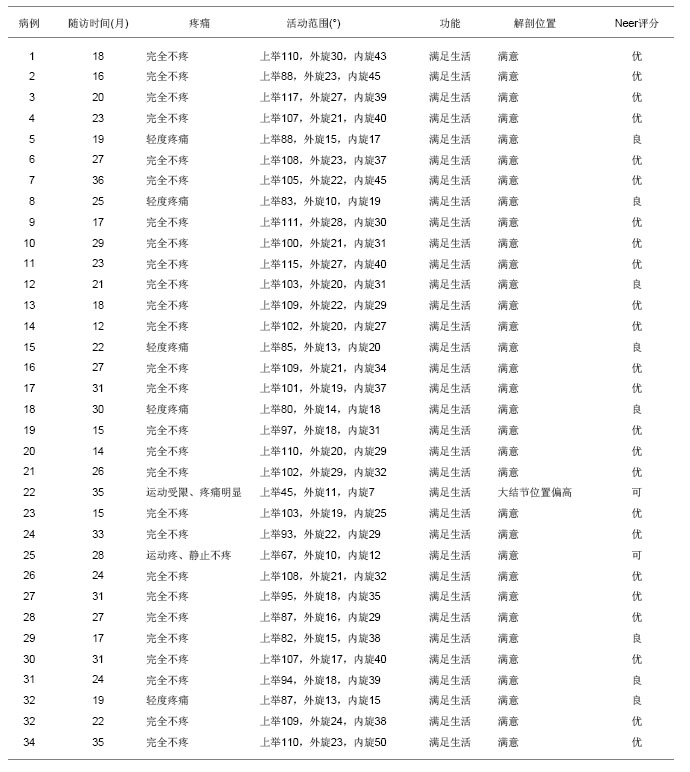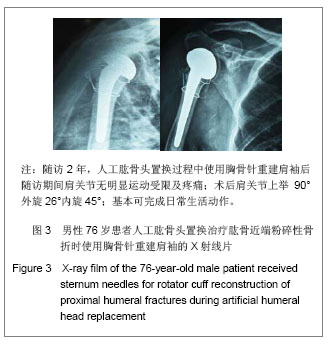3.1 肩袖的重要意义 肩关节是人体内运动功能和稳定性对关节周围软组织要求最高、依赖性最强,活动范围最大的大关节。肩袖是由起于肩胛骨,附着于肱骨头前方的肩胛下肌腱,上方的冈上肌腱,后方的冈下肌,小圆肌腱所共同形成的袖套样肌样结构,这些肌腱的运动不仅控制和改变肩关节旋内、旋外和上举等活动的方向,更重要的是,这些肌腱将肱骨头稳定于肩胛盂上,对维持肩关节的稳定和肩关节活动起着极其重要的作用。于肱骨头球状关节面是肩盂关节面积的3倍,盂肱关节在三维方向具有6个自由度活动范围,肩盂关节面平而浅关节囊和周围软组织韧带相对比较薄弱,对关节的稳定作用有限。Rozing等
[8]通过对肩关节置换患者进行比较,发现术中肩袖修复的质量对肩关节置换后的临床评分影响较大。因此,肩袖对肩关节的活动和稳定性有着无可替代的重要意义。Mestdagh等
[9]提出限制性肩关节假体置换应常规修复肩袖撕裂,以免大结节的肩袖组织叠加到假体头上,并注意保护肱二头肌长头肌腱。在行人工肩关节置换术时仔细修复肩袖非常重要,否者可能会导致人工假体的脱位或半脱位。本组34例肱骨近端粉碎性骨折的患者,都使用胸骨针进行了肩袖的原位重建,术后功能恢复良好。
3.2 肩袖的重建 越来越多的学者认识到人工肱骨头置换最终的效果取决于多方面:患者具体的病情,手术的方式以及术后肩关节的功能锻炼,尤其是对人工假体的安放,术中软组织的修复和重建。术中更坚强的肩袖固定和术后更积极的功能康复训练有助于功能的改善
[10] ,肱骨近端结节部为肩关节周围重要的肌肉附着部,Heers等
[11]认为,肩袖肌群在近肱骨大结节止点处融合为一,肱骨大、小结节骨折的复位与固定情况关系到肩袖止点的重建质量,直接影响到肱骨头置换后的效果。因此肩袖的重建是整个手术中最重要的步骤,牢固地固定大小结节是术后肱骨头假体稳定和肩关节功能恢复的先决条件,并直接影响到患者术后功能锻炼的进行。大结节的异常对肩关节置换术后运动功能影响较大,可能产生肩关节松弛、撞击综合征,肩关节不稳,限制肩关节运动等并发症。
目前国内进行肩袖重建的材料有多种,主要是钛缆、钢缆、缝线或钢丝,其中钛缆和钢缆强度比较高,对骨质及肌肉的切割严重,容易导致骨块破碎及移位,并且柔韧度较差,术中进行操作时较为困难,特别是对于多个骨折块进行复位及固定往往比较困难,还有就是钛缆和钢缆价格较为昂贵,不能广泛使用。缝线线进行重建组织反应小,手术损伤小,但其弹性较高而强度较差,固定不牢靠,无法耐受术后肩关节的功能锻炼。钢丝作为一种金属材料,具有较好的柔韧性和静力加压固定作用,并且价格低廉,各级医院都常备。
3.3 手术体会 胸骨针即带针钢丝线,由于其具有缝合针,所以在进行捆绑固定钢丝时创伤非常小,并且还可进行骨膜下缝合,由于钢丝具有较好的柔韧度且硬度不高,便于多块骨折块复位固定,收紧后使大小结节及肩袖接近解剖复位,并且强度比常用的可吸收缝线要高,还具有较好的静力加压固定作用,固定后能允许早期的功能训练,有利于肩关节功能的恢复。带针钢丝线的特殊结构避免了为了固定骨块而过多而剥离肩袖与骨折块,保留了关节囊与肩袖的关系,局部解剖结构干扰少,有利于碎骨块及大小结节骨折的愈合,从而有利于肩袖的修复,便于整个手术的操作,手术时间缩短,还可降低术后假体感染率。胸骨针价格低廉,为了复位固定牢靠可使用多根,但仍不会增加患者的经济负担。
在肱骨近端骨折人工肱骨头置换肩袖重建中使用胸骨针,既可固定骨折又可修复肩袖,材料简单易行,效果明显,特别是对一些肱骨近端粉碎性骨折的患者,骨折块较多不易固定,多根胸骨针缝合捆扎效果明显好于其他方法。
本组患者术中暴露肩关节和肱骨骨折端时,没有过分剥离骨折块与肩袖组织,保留肩袖组织与骨块相连,便于胸骨针缝合后捆扎及碎骨块的愈合,由于肩关节囊与肩胛下肌为一体, 故不要分离,可将关节囊和肩胛下肌两者作为一个整体进行缝合, 从而维持软组织瓣的强度, 有利于肩袖的缝合,将胸骨针沿着肩袖大小结节表面肌腱-骨结合部环形缝合备用,必要时可用多根,Loebenberg等
[12]认为大结节固定于肱骨头下10-16 mm能最大程度的促进肩关节功能的恢复假体置入后,将肱骨大、小结节及碎骨块解剖复位,收紧胸骨针,大小结节及肩袖附着的碎骨块均原位贴在人工肱骨头下方,肩袖自动包绕肩关节,这样既可使关节周围肌肉肌腱及软组织接近解剖位置,又可防止假体脱位,稳定肩关节。Kralinger等[
13]认为肩关节置换中最重要的一点就是肩袖止点的重建必须尽可能解剖复位,牢固地重建大、小结节是术后肩关节功能恢复的关键。术中应尽可能将残余的肩袖和肌肉组织损伤进行缝合修复, 并要注意缝合后的动力平衡,这对术后的功能恢复非常重要。
3.4 置换后康复锻炼 术后早期、合理的康复锻炼对人工肱骨头置换后肩关节功能的恢复至关重要。Boardman等
[14]对81例全肩关节置换术后患者进行康复锻炼,特别注意维持运动功能和软组织的愈合过程中的问题。70%的患者维持了上举功能,90%维持了外旋。在对患者进行康复治疗时,类风湿性关节炎、创伤性关节炎、骨坏死是妨碍运动康复和肌腱愈合的危险因素。肩关节功能锻炼时要注意循序渐进,先被动后主动,活动量由小到大,避免引起疼痛和损伤关节,全面锻炼肩关节的上举外展外旋内收运动,最大限度地恢复肩关节的功能。根据Neer等
[15]3阶段康复原则指导患者进行功能锻炼。第一阶段(0-6周):被动活动阶段,手术当天患侧肩关节应用吊带固定于中立位防止关节脱位, 可以做邻近关节的主动及被动活动, 并且有利于减轻肢体的肿胀。第二阶段(7-12周):辅助下肩关节早期主动活动阶段,可去掉吊带,开始肩袖和三角肌的等长收缩练习,增强肩关节的肌力。第三阶段(13周后):肩关节抗阻力训练阶段,在患者活动度完全恢复并且无疼痛的情况下使用弹力带及重物等辅助器材达到增强肌力和耐力的效果[16]。值得注意的是,患者的配合程度与术后功能的恢复也是密切相关的,因此通过与患者有效地沟通,让患者意识到术后功能锻炼的重要性,指导其进行康复训练,才能达到满意的效果。
总之,肩关节置换中最重要的一点就是肩袖止点的重建必须尽可能接近解剖复位,牢固地重建大小结节是术后肩关节功能恢复的关键。使用胸骨针进行肩袖修复及大小结节的固定能使肩袖和大小结节接近解剖位置,并且胸骨针价格低廉,使用范围广,复位效果满意,固定牢靠,能满足术后康复训练的需要,对术后肩关节的稳定及功能的恢复有重要作用。相信,随着人工肱骨头置换此项技术的逐步走向成熟,在更多的医院得到广泛应用,也将会给越来越多的患者带来福音。



.jpg)